A Case of Med(dling)tation
Abbas Zahedi and Sadie Murdoch
- Presented by — Belmacz
- Abbas Zahedi and Sadie Murdoch with Toby Upson, A Case of Med(dling)tation, 2021, for Belmacz, part of Performance Exchange London, 10th July 2021. Image Courtesy Performance Exchange and Belmacz. Photo: Damian Griffiths.
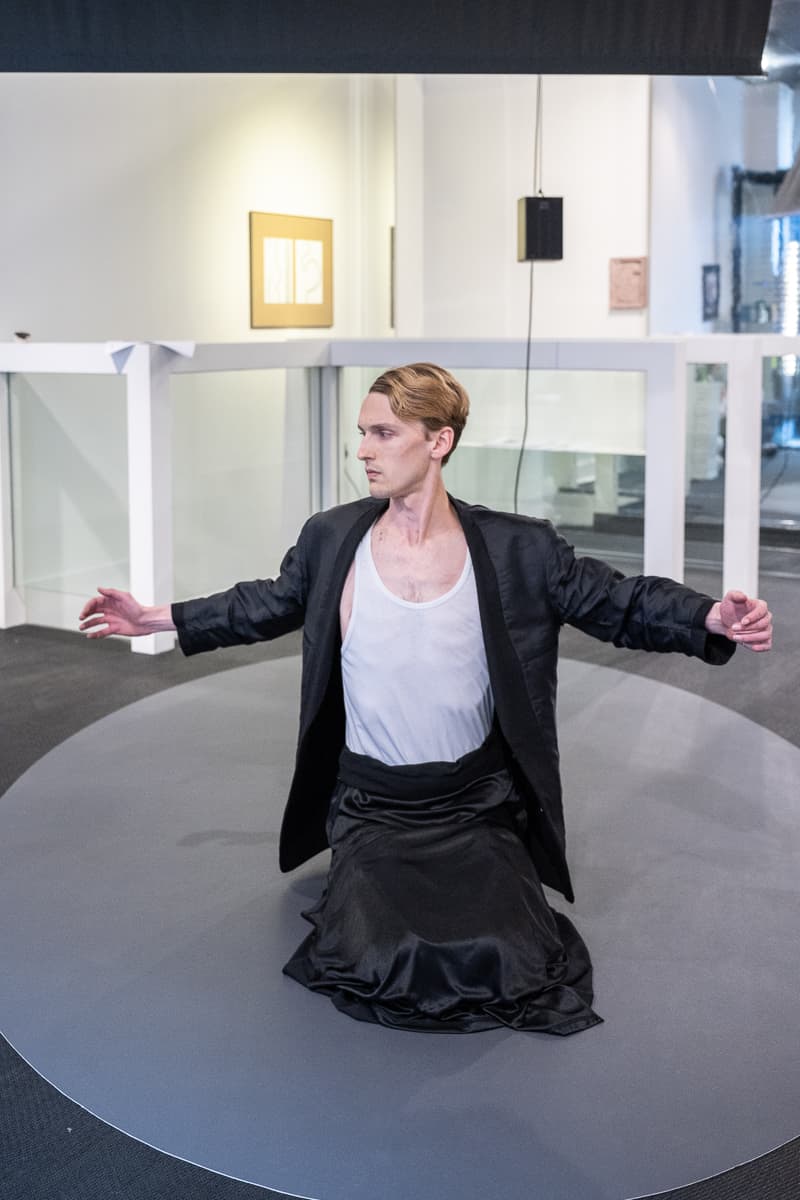
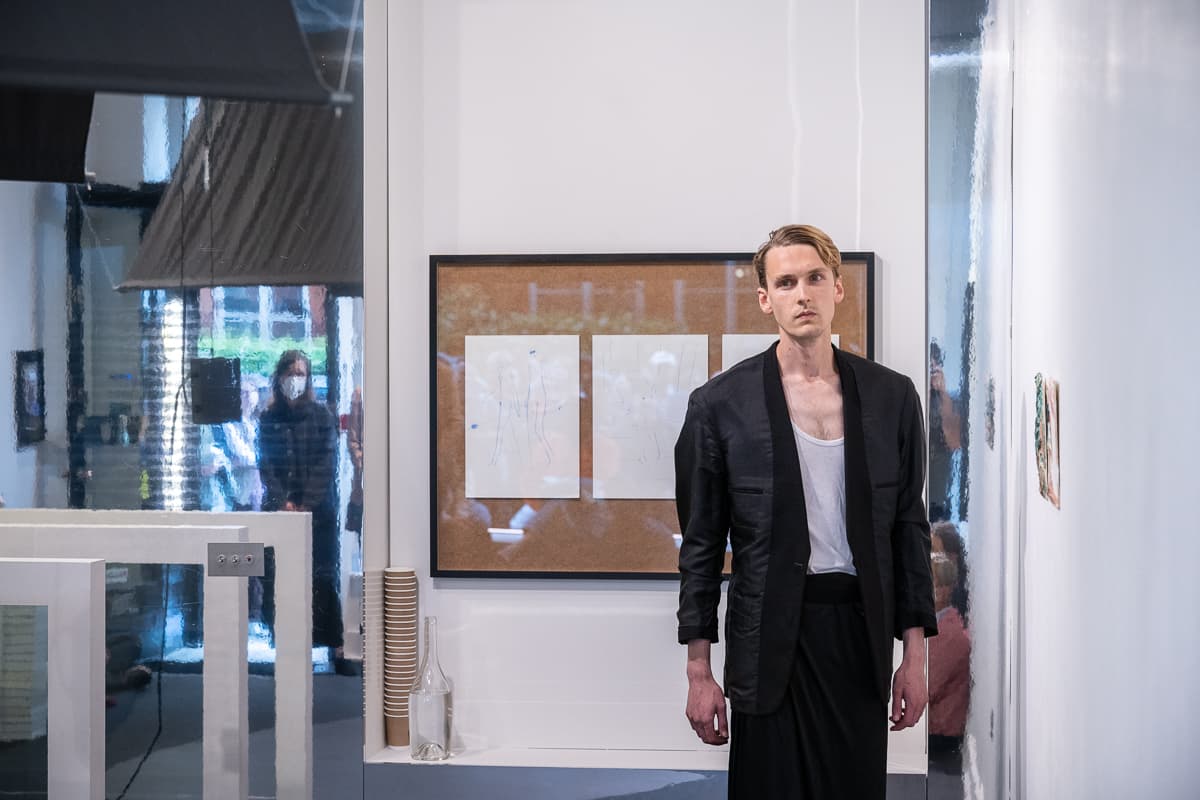
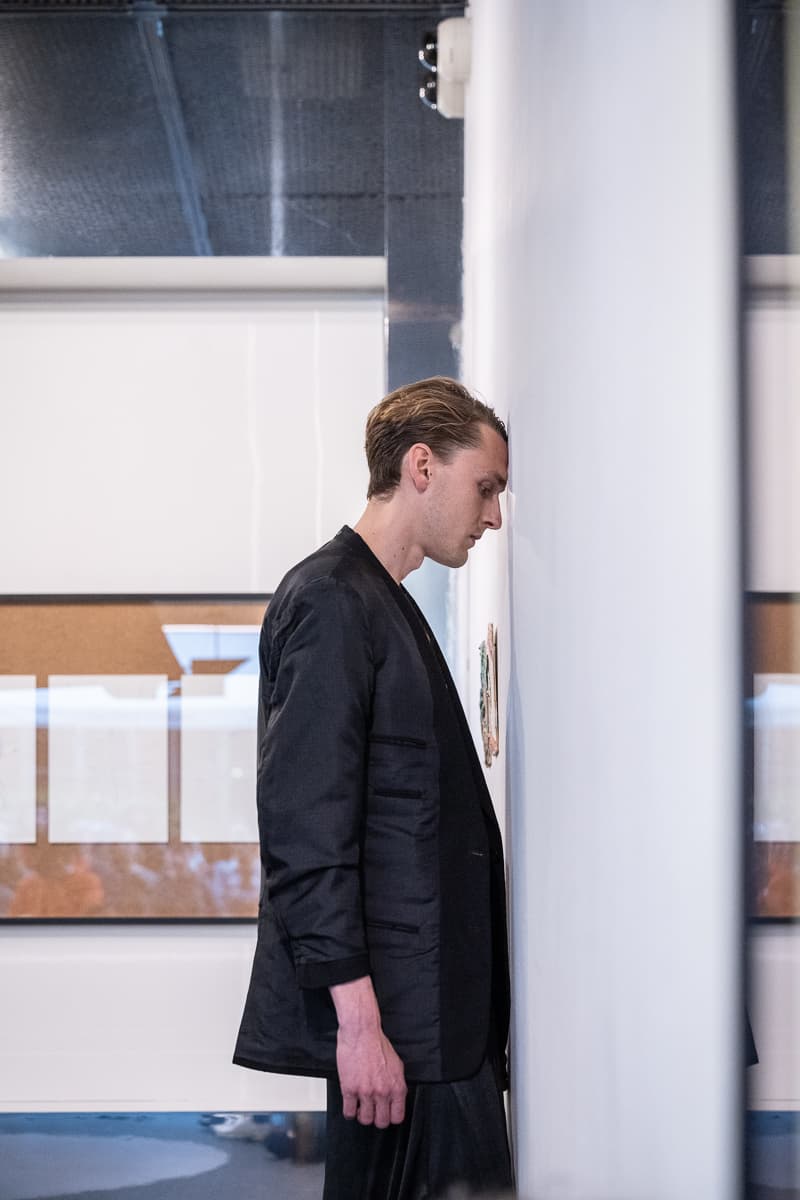
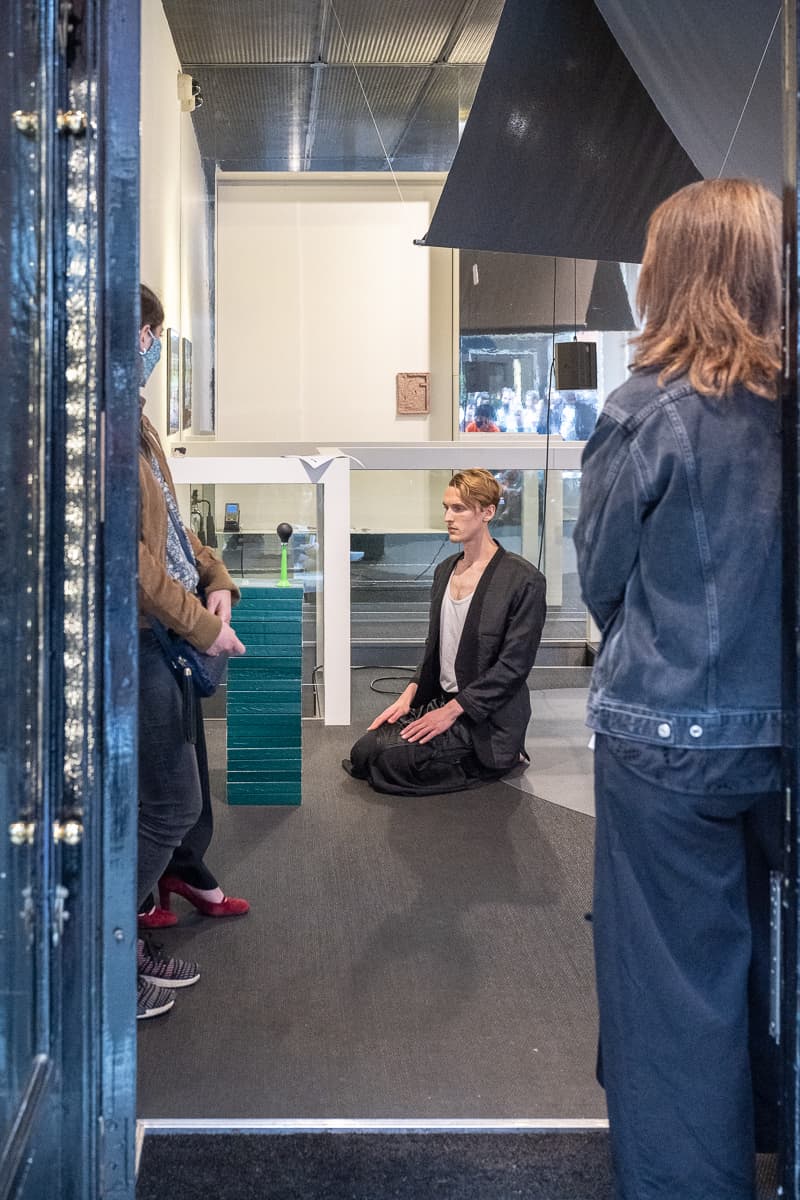
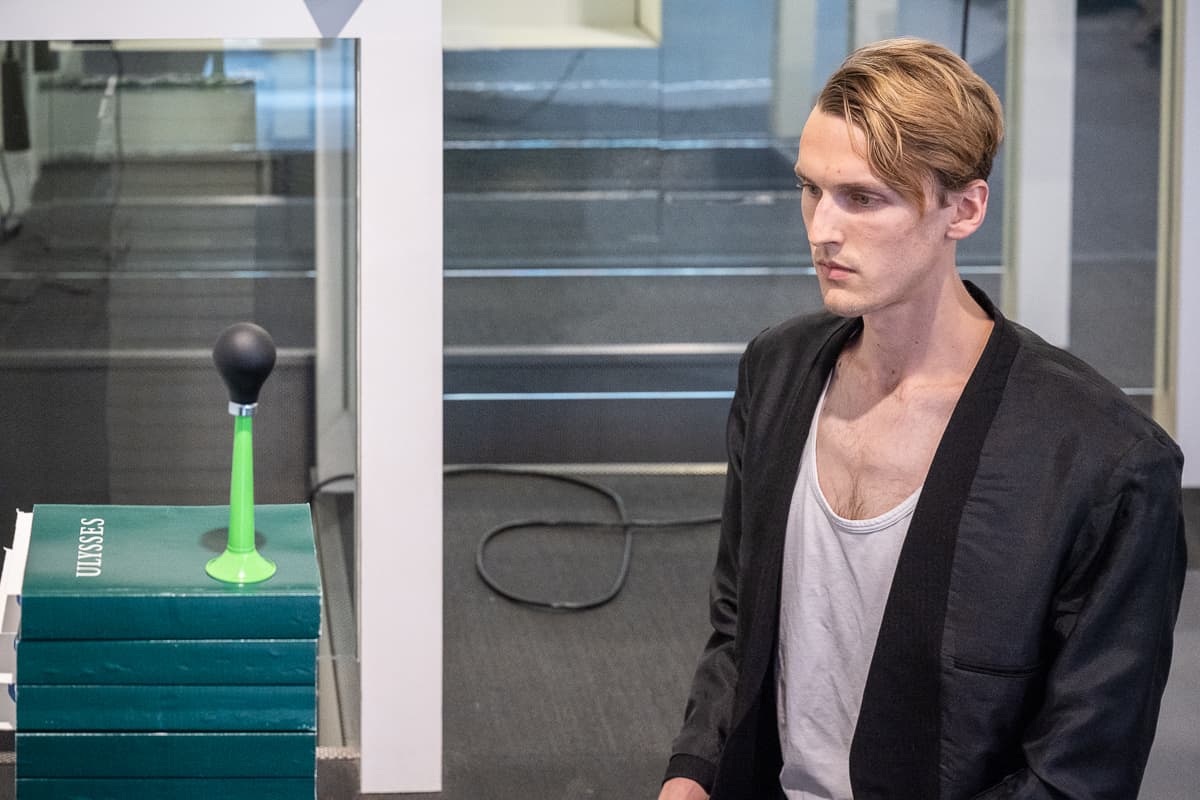
Drawing upon both Sadie Murdoch and Abbas Zahedi’s connection to and history working with language — written and spoken — A Case of Med(dling)tation (2021) takes James Joyce’s performative use of the written form, as well as those with proximity to his lineage, as a starting point for wider ruminations on notions of mediated (dis)connection. Specifically, the commercialisation of affect and the practices of surveillance innate to modern forms of ‘escape’ — be these fantastical or holistic.
Working together for the first time, the artists share a fascination with using language as an extra-performative medium, and this new performative and sound based work mirrors the ways in which writers, such as Joyce (and his Irish peer Samuel Beckett), used words to create multi-tonal macrocosms: worlds in themselves surveilled and sanitised, censored and stabilised.
Through sound, script, and minimal action, A Case of Med(dling)tation can be seen as a ‘guided medi-ation’: a gesture riffing off meditation apps to explore both the gaps within, and between, linguistic forms as well as the potential arising when one slips between these fixed states. Absurd yet holding, the 24 minute performance and sound piece is not so much a passive activity; rather as Beckett might remind us, it is a performance in which we must show up.
Description of the Work
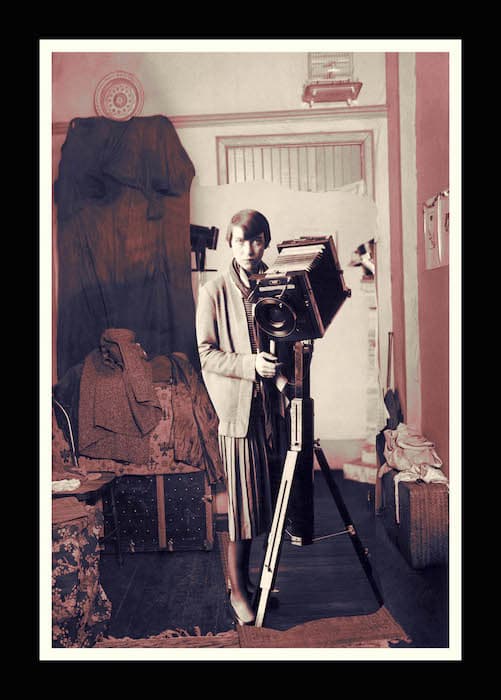
En-tuned to a guided audio medi-ation — a soundtrack, including a scripted voice over — a nondescript performer moves through a space silently.
They wear similarly nondescript clothing — a skirt, a jacket, leggings — in monotones of grey. These garments are worn inside out. The person is barefoot, tentative.
Entering the space, this person places a klaxon upon the floor. It is present throughout the performance.
Though the sound of the guided audio medi-ation — a genteel and well-cultured voice paired with uncanny rhythms — is audible throughout the space, it is not clear if the person in movement is aware of the possible fellows joining them in the space. They move intuitively, in silence through the space, in accord with, in resonance too, the sounds and script they hear.
The voice of the guided audio medi-ation reads a text: soft, one in which the spacing between words is out of sync; tranquil, one in which new words are made from semiotic fusings and other words are loosened from the syntactical grip of the sentence; relaxing, one where instruction and feeling are professed as and in one. Drawing upon meditation apps, this language is understood because the spaces between the words enunciated could be mis-read and/or mis-placed.
Pared with contemporary sounding rhythms, the effect of the audio medi-ation is wholly evocative in its seeming incongruity; its disconnected-connected-ness.
The medi-ation ends with an act of generosity: the sounding of the klaxon by the nondescript person.
Conditions of Production
Space Requirements
The performance will start inside an enclosed space - the space of a gallery for example that is large enough for the performer to move freely around the audience. The performance may move outside of this immediate space, but will need to end in the location of the klaxon.
Audience members will be positioned in and through the performance space and are encouraged to stand clear of the performer and klaxon.
Technical requirements and props
A handheld klaxon.
Bluetooth speakers (enough to fill the space with sound), connected to an audio player. These should be in sync, playing the guided audio medi-ation harmoniously.
Performer
The performer will need to wear a jacket, a skirt and leggings - these should be monochromatic shades of grey, without patterns. These items of clothing will need to be worn inside out. The performer is to be barefoot.
One performer will be needed to complete the piece.
This should be a nondescript person. That is, a person of any age, any gender, any ethnicity. This person must not be ‘outlandish’ in their appearance: hair should be worn down and flat; piercings - where they cannot be removed or hidden - should be a simple stud; any tattoos should be hidden as best possible; glasses are permitted if these are simple wire frames, without branding.
The performer will not need to have specific training. However, they will need to have a good level of dexterity, the ability to perform without inference from an audience, and an ability to perform intuitively in response to the guided audio medi-ation.
The performer will need to be made familiar with the specific space of the performance, as well as the rhythm of the audio. Time and costs for rehearsal should be built into any production of the work.
The performer will need to have a good understanding of the performance’s soundtrack - the guided audio medi-ation. The guided audio medi-ation’s script will not include stage directions. Rather the performer will need to act with intuition, responding silently to the guided audio medi-ation through minimal gesture and bodily movements. They may kneel on the floor but are encouraged not to lay down or use the architecture of the performance space as an extension of their responsive movements. The performer cannot act with erratic or grand movement. All bodily acts should be en-tuned to the guided audio medi-ation.
Rules of Documentation
Members of the audience, as well as the producing party, will be allowed to document the performance for their personal use.
The producing party and artists will not formally document the performance. Any documentation will be an aside to the work and cannot be used for public display or marketing purposes. The soundtrack (guided audio medi-ation) should not be documented in its entirety.
Other conditions of sale
The acquisition of the performance includes the acquisition of one of the soundtrack editions - edition number 1.
The 23 remaining sound track editions are available for acquisition as stand alone artworks. These will be distributed as digitally mastered sound files. These can be presented on individual headphones, or spatially within an enclosed, and suitably ‘meditative’ space. Full details are available on request.
Loan/Resale
One or ideally both artists, or their representatives, should be contacted prior to any re-staging of the performance
Any representation or re-staging of the performance will need to credit Sadie Murdoch, Abbas Zahedi, and Belmacz.
Copyright/IP
Sadie Murdoch and Abbas Zahedi will be fully credited for the performance. The performance is a unique work, with 2 artist proofs.
The soundtrack will be credited to Sadie Murdoch and Abbas Zahedi. The soundtrack will be an editioned work of 24 with 2 artist proofs.
The acquisition of the unique performance will include an edition of the soundtrack.
The performance, as a whole, will belong to Belmacz, as the commissioning gallery until the point of acquisition or sale.
Any representation or re-staging of the performance will need to credit Sadie Murdoch, Abbas Zahedi, and Belmacz.
Given the intuitive nature of the performance - the performer’s individual response to the guided audio medi-ation - it is expected that each re-staging of the work will be different in its formalities - the gestures and movements enacted by the performer.
Collectables
- The soundtrack (guided audio medi-ation) will be a stand alone editioned work, credited to Sadie Murdoch and Abbas Zahedi (edition of 12, + 2 artist proofs)
- The script of the guided audio medi-ation’s voiceover
- The garments worn by the performer
- One klaxon horn